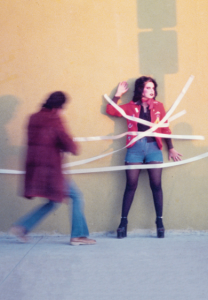ASCO Exhibit In LA Highlights 1970s Chicano Performance Art
 “ASCO: Elite of the Obscure” is a new exhibit slated to start on September 4 at the Los Angeles County Museum of Art, representing a watershed moment in the history of plastic arts for Latinos, and for Latino Angelinos in particular, as all four members of the collective, Willie Herrón, Harry Gamboa, Patssi Valdez, and Gronk, grew up on the streets of East Los Angeles.
“ASCO: Elite of the Obscure” is a new exhibit slated to start on September 4 at the Los Angeles County Museum of Art, representing a watershed moment in the history of plastic arts for Latinos, and for Latino Angelinos in particular, as all four members of the collective, Willie Herrón, Harry Gamboa, Patssi Valdez, and Gronk, grew up on the streets of East Los Angeles.
The currency of the exhibit is decidedly photography; four large salons contain large prints of the performances the group used to mount on the streets of East Los Angeles like “Stations of the Cross,” “Walking Mural,” and “First Supper (After a Major Riot).” So, don’t come to this exhibit because you like the work of Diego Rivera, or because you find murals titillating. Come because you believe in the intersection between activism, democracy, and public art.
In a 2007 interview conducted by L.A. Weekly, Gamboa says he was instrumental at Garfield High in the East L.A. high school walkouts of 1968, and participated in the Chicano Moratorium against the Vietnam War in 1970. In fact,the collective and the group’s name — asco, as in disgust or revulsion — is a response to the disgust and nausea that Gamboa felt in 1972 when he visited LACMA and realized there was no paintings by Chicanos in the museum. In many ways, the “art” in “Elite of the Obscure” becomes the process through which the viewer recreates the performances ASCO staged in 1972 to bring to light many of the inequalities suffered by Latinos, despite major contributions to the infrastructure, history, and economic well-being of the U.S.
Supposedly, on that day in 1972, Gamboa hunted down the curator and asked them about the lack of Chicano art on the walls, to which the curator replied, “Chicanos don’t make art, they join gangs.”
Asco is also what many people felt after seeing the performances of the collective. In a way, the exhibit is also a watershed moment for the museum; LACMA is the same museum Ed Ruscha depicted smoldering from the back in his painting “Los Angeles County Museum on Fire.” Certainly, the argument could be made that LACMA’s collection has decidedly become less Anglocentric since Ruscha’s painting, and decidedly more inclusive. 2010’s popular show, “Phantom Sightings,” also curated by Rita Gonzalez, surely proved what can happen when the museum bets on ethnic. Furthermore, LACMA sees the group worthy of a retrospective is indicative of a growing trend among museums to accession rare, esoteric materials outside the established canon which includes graffiti and aerosol paintings by reputable graffiti “writers.” The popularity of documentaries like, Exit Through the Gift Shop is also testament to this aesthetic.
“Elite of the Obscure” adroitly displays the documents of ASCO’s publications, performances, and “no movies.” The original collective’s output was not what you might call prodigious, but they were all driven by an ethos of revulsion at the stereotypes and the idiosyncracies of Latino culture; the only evidence, for example, of their performance for “Stations of the Cross” is a series of photographs snapped by Seymour Rosen. “Elite of the Obscure” includes several issues of Regeneración, the magazine the collective produced. Several issues of the magazine are laid out on display boards, like specimens; mock-ups, galleys, and flyers are displayed as well. Regeneración served as a mast for the collective’s endeavors at the onset of their trajectory, and special care is taken to display these objects. Do not come to this show expecting to see paintings and sculptures of Chicano art; instead, you get the photographs of the performances that the collective expressed, nothing more and nothing less.
The exhibit is curated by Rita Gonzalez, LACMA’s curator of contemporary art, and C. Ondine Chavoya, associate professor of art and Latino/a studies at Williams College; and, the exhibit travels to William College after it’s run at LACMA. Elite of the Obscure is proof that even the most Anglocentric institutes can get it right, and display the wide range of artistic accomplishments and registers that may come from any ethnicity. Come to this show because you find esoteric work sometimes more satisfying than paintings fetching millions; come to this show to see a piece of Los Angeles that doesn’t exist anymore, and a piece of Los Angeles in a future where Latinos are the majority minority and in control of the message that gets out.
[Photo By LACMA]
